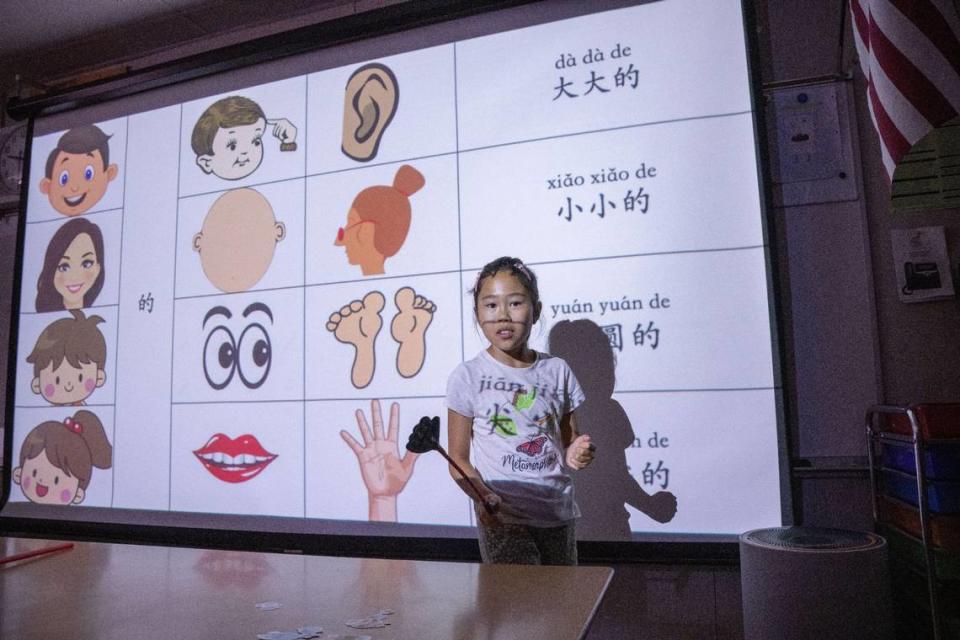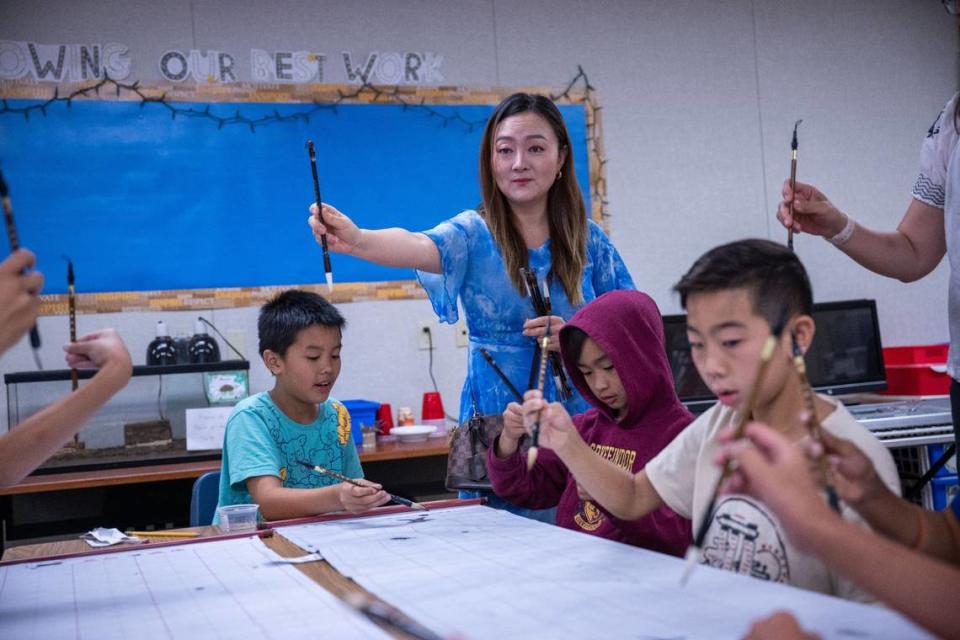Sacramento has 7 dual-language grade schools. What happens when students go to junior high?
Growing up, Melissa Quon traveled an hour on Saturdays to attend a Chinese class in San Francisco. The teaching style was stern and “old school”, she said: “you say it, you repeat it, you write it.”
“I didn’t go very long,” she said. Despite being of Chinese descent, Quon said she now “doesn’t speak Chinese very well at all.”
Wanting her two sons and daughter to retain a connection to their culture, she enrolled them in the K-6 Chinese immersion program at William Land Elementary School. The difference in methodology and results compared with the weekend school were “night and day,” she said.
The pioneering program starts kindergarteners with classes almost entirely in Mandarin, incrementally progressing to a 50/50 split with English over time. The classes are “interactive, age-appropriate, like a regular kindergarten class,” Quon said, ultimately helping her kids “grow up feeling like it’s okay to learn about their culture, feeling like it’s a normal thing…(when) in regular class, it’s considered different even though we live in a pretty diverse community.”
The Mandarin immersion program is one of seven dual language immersion programs in the Sacramento City Unified School District, with 238 of the district’s 922 K-6 immersion students. One other program is taught in Cantonese, one in Hmong, and four in Spanish.
While the elementary school programs are a “great experience,” kids are left unsupported once they graduate, parents said. With no higher level Chinese or Hmong classes in middle school, parents are left to figure out themselves how to continue supporting their kids’ language learning, bridging the gap to high school classes or an AP test.
Now, after years of advocacy by parents, a $5 million proposal to expand Chinese, Spanish and Hmong language immersion programs to middle and high school appeared in a Sacramento City Board of Education meeting for the first time on May 18.
The proposed funding didn’t make it into the district budget approved June 22, but board President Chinua Rhodes said the board will continue to consider it in the 45-day revision period after the state finalizes its budget.
Sacramento immersion programs play unique cultural preservation, economic mobility roles
The Mandarin immersion program at William Land Elementary School, which has between 20 and 25 students per K-6 grade, has students of various ethnic backgrounds. Parents say they value the unique language-learning and normalization benefits of an immersion program.
The immersion program eliminates “embarrassment” from speaking another language, said Virginia Tsai, a parent with one graduate and one current fifth grader in William Land’s immersion program.
“Going to Chinese school on weekends, you’re kind of reluctant to speak it in your regular school because no one else speaks it. But I find in the setup of an immersion program, everyone’s speaking Chinese, your teachers are, your classmates are…that’s the special part of being in an immersion program,” she said.

Bao Moua, the principal at Susan B. Anthony Elementary School, which houses the district’s Hmong language immersion program, said that cultural preservation is also a big goal for parents with kids in the program.
“I wanna say about 90% of our students, even though they’re of Hmong background, they come to us without speaking any Hmong,” she said. Of 310 students at the school, around 140 are in the Hmong language immersion program, Moua said.
Rhodes said that boosting economic mobility is also a goal of the programs. Many students in the district’s Spanish programs have parents who are English learners. The language program makes instruction more accessible to them.
Rhodes represents Meadowview and Parkway neighborhoods in South Sacramento, which include Susan B. Anthony as well as Cesar Chavez and Edward Kemble Elementary Schools, which both have Spanish immersion programs. His son is enrolled in a Spanish immersion program.
For his son and other non-English learner students, “in the global economy, especially here in California, him understanding and knowing Spanish is going to be a great help to his overall opportunities,” Rhodes said.
Tsai said that Mandarin is similarly a useful language to know given the international context.
“I think China’s going to have a big role in the future internationally, so I think it will be a really useful language for (kids) to have, for the next generation,” she said.
Lack of middle school language classes creates a ‘gap’ in language pathway, advocates say
Given the lack of language classes or programs at the middle school level, “it’s hard” for parents to support their children after graduating from elementary school immersion programs, Tsai said.
“We now attend an online Chinese class. It’s once a week for an hour and a half. The teachers are from mainland China, and they follow a textbook,” Tsai said.
While Moua said there are high school Hmong classes coordinated with the immersion program at Susan B. Anthony, no appropriate high school Chinese classes exist for Mandarin immersion program graduates, Tsai said. The only goal parents can aim for is to have their kids “take the AP test (in ninth grade) and at least have something to show for all the years that you’ve put in,” she said.
Since the first cohort of immersion students at William Land in 2011, Mandarin immersion program parents have advocated for an expansion of the program to middle and high school, said Enoch Yeung, a parent of two program graduates.

Mostly, the advocacy has involved meeting with board members and district staff, as well as mobilizing parents and students to speak at board meetings. Tsai asked teachers at William Land to send messages about board meeting delegations out to parents of kids in the program several times per year, she said.
“The hard part is, a lot of parents of the students, English might be their secondary language, so they might not be comfortable speaking to the school board, or they don’t understand how the school system works in the U.S.,” Tsai said.
In the 2021-22 school year, parents were also able to directly raise money for a combined seventh and eighth grade advanced Chinese class at Sutter Middle School, where many Mandarin immersion program students go.
The district expressed potential support for continuing to fund the class, Yeung said, but the support fell away due to “a lot of different maneuvers” surrounding the end of COVID restrictions and the district’s negotiations with its teachers union. The class did not continue in the 2022-23 school year.
Though William Land parents have most consistently advocated at board meetings, advocates for expansion have also come from Hmong and Spanish immersion programs.
“We have had parents from our Spanish immersion program … come in and advocate for their program being expanded,” Rhodes said.
Moua said that she has spoken in favor of Hmong immersion program expansion to district staff.
“I have not been in contact with parents from the Mandarin program, but (expansion) is something that our parents would also like … they don’t have the resources to push that piece, but they are interested in having that bridge in middle school,” Moua said.

Conversations ongoing about expansion funding
Progress on expansion picked up once Rhodes was elected to the board, Yeung said.
“Chinua, because he was kind of strategically located in the south area and had two immersion programs under his jurisdiction, we were able to talk together and make more of a push,” Yeung said.
Tsai credits Rhodes with finally bringing an expansion proposal to the board discussion on May 18.
“The main thing we wanted was to get it on the agenda for discussion, because we could never move beyond the public comments,” Tsai said. “This is as far as we’ve gotten ever before.”
No funding has been allocated yet for the expansion, or specific plans made for class sizes or what schools expanded programs will be housed at, Rhodes said, though the middle school gap is specifically being targeted.
If an expansion is pursued, the board will work with its facilities department to identify where the programs would be housed to “be most useful and…accessible to our broader community,” Rhodes said.
Though the 2023-24 budget that the board approved on June 22 did not allocate any funding for language program expansion, there is a 45 day revision period for the board to “come back and allocate new things to the budget,” Rhodes said, and conversations are ongoing.
“It’s something that we’re definitely looking at still and having the conversations. I’ve been having conversations around this since I’ve been elected,” Rhodes said.

The rocky history of language immersion programs in California
Dual-language programs in California have oscillated between having robust support and fierce opposition.
In 1998, California voters passed Proposition 227, which declared that “all children in California public schools shall be taught English by being taught in English.”
The full text of the proposition attacked bilingual programs – developed with support from the 1968 federal Bilingual Education Act and after advocacy from Latino, Chinese and other activists – for “wasting financial resources on costly experimental language programs.”
The proposition reflected anti-immigrant backlash beginning in the 80s that eroded bipartisan support for bilingual programs as a means of cultural preservation and shifted focus to teaching students English fluency as quickly as possible, according to research by Erin Kinney at Hamline University.
At the time, California had 410,000 students enrolled in bilingual education and more than a million English learner students, according to 2003 research by Boston University professor Christine Rossell funded by the Public Policy Institute of California. Proposition 227 cut bilingual enrollment by as much as two-thirds, according to Rossell’s research.
In 2016, the tide turned when voters repealed Proposition 227 by passing Proposition 58. In 2018, the California Department of Education threw its support behind bilingual education by undertaking an initiative to have “half of all K–12 students … participate in programs leading to proficiency in two or more languages’‘ by 2030 and “three out of four students to be proficient in two or more languages” by 2040.
The number of California schools with dual-language programs increased quickly afterwards, from 407 in 2016-17 to 747 in 2018-19. The Los Angeles Unified School District had 137 dual-language programs in 2018-19, and school districts in San Francisco, San Diego and elsewhere also offer dual-language pathways in a variety of languages at elementary, middle and high school levels.

